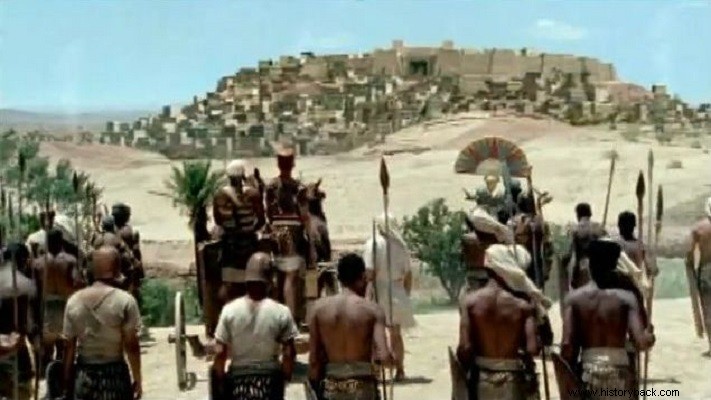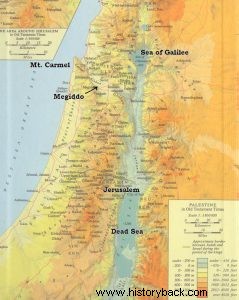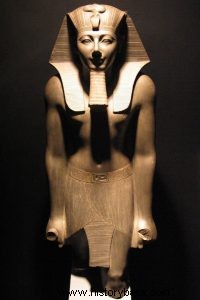
The battle of Megiddo took place in the 15th century. e.g. and has the unique distinction of being the first battle of which there is any historical record. At Megiddo, the Egyptian army of Pharaoh Thutmose III clashed with a Canaanite army under the king of Kadesh.
It is also the first battle in which the casualties of the opposing armies are given and the first use of the compound bow is recorded. According to the ancient Egyptian sources the battle took place on April 16, 1457 BC. Other sources place it in 1482 or 1479 BC
The Egyptian first line of defense
Thutmose III was the pharaoh who led ancient Egypt to the height of its territorial expansion and power. The Canaanite kingdoms in what is now Israel, Syria and Lebanon were Egypt's first line of defense against the mighty Hittite Empire, acting as vassal states of Egypt.
The Canaanites, however, encouraged by the Hittites and the Mitans, decided to rebel against their Egyptian overlords, led by the king of the well-fortified city-state of Qadesh. Megiddo is located in northern Israel and was a strategic point in the region, also being the southward "shield" of the king of Kadesh. Megiddo controlled the main route from Egypt to Mesopotamia.
Thutmosis invades
When the pharaoh learned of the rebellion he headed a strong army of 10-20,000 men consisting of war chariots and infantry towards Megiddo. The king of Qades and his counterpart of Megiddo, also began to gather their forces, eventually fielding 10-15,000 men. In addition to their own men, they had Syrians, Arameans and other Canaanites.
The Egyptian army after a 10-day march reached friendly Gaza and then continued north. Passing Mount Carmel, the Egyptians finally approached Megiddo. There were three roads leading to the city.
Both were relatively passable. But one was difficult and dangerous. Despite the advice of his generals, Tuthmosis followed the difficult path, telling his generals that this was exactly what the enemy would not expect.
Indeed the king of Qades had sent strong detachments to guard the exits of the two passable passages, but not the impassable one. Thus Thutmose and his men not only found themselves without a problem before Megiddo, but also the army of his opponent was dispersed.
Battle and siege
Tuthmosis did not miss the opportunity and after encamping outside the city, at first light the next day he attacked. The king of Qades having suffered a strategic surprise did not manage to recover. Although his forces held higher ground and thus had a tactical advantage, they were nevertheless unable to withstand the Egyptian onslaught.
About 1,000 tanks and the aforementioned infantry forces on each side seem to have participated in the battle. Thutmosis personally led the attack against the enemy center, but at the same time he had ordered his forces to attempt to flank the enemy line.
The pharaoh's momentum and super waxing maneuver paid off. After all, the army of the king of Qades was not homogeneous, like the Egyptian one. Panic soon ensued as the Egyptian chariots mowed down the opponents.
The Canaanites put it to rest. Those who were near the city ran for safety within the walls, closing the gates and leaving the rest of their colleagues to be slaughtered by the Egyptians. The king of Kadesh and the king of Megiddo caught up and entered the city. Some soldiers were saved as the townspeople threw them ropes from the ramparts through which they scaled the walls.
But thousands of others didn't make it. According to Egyptian records thousands of enemies were killed and captured. Following his victory, Tuthmosis besieged the heavily fortified city. It took a siege of seven whole months to compel the defenders to surrender. According to Egyptian records the Canaanites had over 11,000 casualties in the battle and the siege.
The Egyptians also captured 924 enemy chariots and 200 pieces of armor, thousands of horses, cattle and sheep. And the Egyptian losses were significant – about 5,000 dead and wounded.
Contrary to the practice of the time, politically minded Thutmosis, did not destroy the city, nor kill the inhabitants . In this way other cities also surrendered. However, other campaigns were needed to consolidate Egyptian rule.
It is worth noting that from the word Megiddo, according to some, comes the biblical word Armageddon, which is related to the great final battle of the End Times.


Pharaoh Thutmose III, as depicted in a statue in the Luxor museum.
